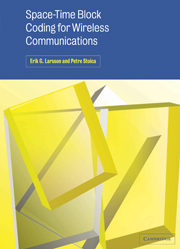Book contents
- Frontmatter
- Contents
- ABOUT THE AUTHORS
- PREFACE
- NOTATION
- COMMONLY USED SYMBOLS
- ABBREVIATIONS
- 1 INTRODUCTION
- 2 THE TIME-INVARIANT LINEAR MIMO CHANNEL
- 3 MIMO INFORMATION THEORY
- 4 ERROR PROBABILITY ANALYSIS
- 5 RECEIVE DIVERSITY
- 6 TRANSMIT DIVERSITY AND SPACE-TIME CODING
- 7 LINEAR STBC FOR FLAT FADING CHANNELS
- 8 LINEAR STBC FOR FREQUENCY-SELECTIVE CHANNELS
- 9 COHERENT AND NON-COHERENT RECEIVERS
- 10 SPACE-TIME CODING FOR INFORMED TRANSMITTERS
- 11 SPACE-TIME CODING IN A MULTIUSER ENVIRONMENT
- A SELECTED MATHEMATICAL BACKGROUND MATERIAL
- B THE THEORY OF AMICABLE ORTHOGONAL DESIGNS
- REFERENCES
- INDEX
A - SELECTED MATHEMATICAL BACKGROUND MATERIAL
Published online by Cambridge University Press: 31 October 2009
- Frontmatter
- Contents
- ABOUT THE AUTHORS
- PREFACE
- NOTATION
- COMMONLY USED SYMBOLS
- ABBREVIATIONS
- 1 INTRODUCTION
- 2 THE TIME-INVARIANT LINEAR MIMO CHANNEL
- 3 MIMO INFORMATION THEORY
- 4 ERROR PROBABILITY ANALYSIS
- 5 RECEIVE DIVERSITY
- 6 TRANSMIT DIVERSITY AND SPACE-TIME CODING
- 7 LINEAR STBC FOR FLAT FADING CHANNELS
- 8 LINEAR STBC FOR FREQUENCY-SELECTIVE CHANNELS
- 9 COHERENT AND NON-COHERENT RECEIVERS
- 10 SPACE-TIME CODING FOR INFORMED TRANSMITTERS
- 11 SPACE-TIME CODING IN A MULTIUSER ENVIRONMENT
- A SELECTED MATHEMATICAL BACKGROUND MATERIAL
- B THE THEORY OF AMICABLE ORTHOGONAL DESIGNS
- REFERENCES
- INDEX
Summary
This appendix is intended to help the reader by summarizing some known formulas and results from matrix algebra and probability theory. It is absolutely not a selfcontained treatment of linear algebra or probability theory, nor is it a replacement for a systematic treatment or a course on these topics. However, it may be helpful as a refresher for students who have not studied these subjects for some time.
All the results presented here are well-known and their proofs can be found in many textbooks on linear algebra, probability theory and statistics. Since our discussion is somewhat scattered, and since we believe that the proof of some of the results can constitute appropriate problems for students when this book is used in a classroom setting, we present most of the results in the form of exercises.
Complex Baseband Representation of Bandpass Signals
Most signals in a wireless communication system have a narrowband character, and such narrowband (real-valued) signals can be represented with complex variables in a neat way. The general theory for doing so is treated in most digital communication textbooks (see, e.g., [Proakis, 2001, Sec. 4.1]), but since the complex baseband representation is a foundation for all signal models used in this book we offer a brief treatment of the topic.
- Type
- Chapter
- Information
- Space-Time Block Coding for Wireless Communications , pp. 235 - 246Publisher: Cambridge University PressPrint publication year: 2003



